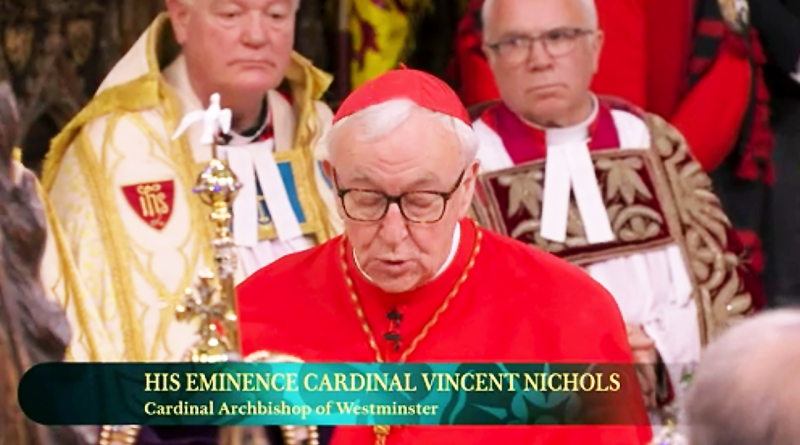Catholic Cardinals, bishops and diplomats all played their part in Coronation of King Charles III
The Coronation of King Charles III and Queen Camilla in Westminster Abbey was an historic occasion for the nation, and also for the Catholic community. For the first time in over 400 years, a Catholic Archbishop took part in a Coronation service in this country. Cardinal Vincent Nichols was not only be present, but offered a blessing alongside other Christian leaders.
The Holy See’s Secretary of State, Cardinal Pietro Parolin, represented Pope Francis with the newly-appointed Apostolic Nuncio to Great Britain, Archbishop Miguel Maury Buendía.
In a 2nd May tweet, British Ambassador to the Holy See Chris Trott said, “We are thrilled that Cardinal Parolin will represent Pope Francis at the Coronation,” noting that the last cardinal to do so “would probably have been Reginald Pole. In 1553.”
The Catholic Archbishop of Cardiff, Mark O’Toole also attended the Coronation, as did Bishop Hugh Gilbert of Aberdeen, Scotland and the Archbishop of Armagh and Primate of All Ireland, Eamon Martin.
Seventy years ago, it would not have been permitted for any Catholic to enter a Protestant church, let alone to take part in a Coronation service.
Ahead of the ceremony, the Cardinal said that his significant step was the fruit of decades of ecumenical relations.
“It’s symbolic of the whole ceremony because it respects our history, builds on our history, and complements the history, both in this way, and with the presence and greeting of the faith leaders from the other major religions now present in this country.”
In a 5th May 5 tweet the Cardinal said he was “privileged” to take part in the coronation ceremony, saying he’ll be standing beside the Archbishop of Canterbury and other Christian leaders “to invoke God’s blessing on His Majesty the King.”
The wording of the Cardinal’s message was:
“May God pour upon you the richness of his grace, bless you and keep you in his holy fear, prepare you for a happy eternity, and receive you at the last into immortal glory.”
For many centuries prior to the Reformation, a Coronation of a monarch was a Catholic ceremony, and today’s ceremony still contained elements familiar to most Catholics as they are found in our liturgies and the celebration of the sacraments – and included the singing of the Kyrie, the Veni Sancte Spiritus, the Te Deum and the Gloria, in a setting written by William Byrd for recusing Catholics in the 16th century.
Asked about the King’s oath to uphold the Protestant succession in juxtaposition to the Cardinal’s participation in the Coronation, the Cardinal explained that the oath is a constitutional act that is an “expression of our desire for continuity” and is important for our “stability and constitutional maturity” as a nation.
The presence of other Christian leaders and leaders of different faith communities, on the other hand, spoke to the King’s commitment to maintaining the way of life of this country, with its openness to all faiths, permitting the free expression of these faiths, and joined to the nation’s Christian roots.
The Cardinal said this was an expression of our history, emphasising the importance of reading the landscape of churches and ruined abbeys, even if we are not attached to them.
“We need to read our own history as well as our present,” he said, “because, if we’re going to understand ourselves and our nation, our culture and the world that we travel every day, we have to know what those buildings stand for.
“Actually, they stand for some of the most profound human truths – the truths of our humanity, of the dignity of the person, the importance of community.”

